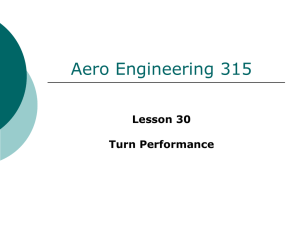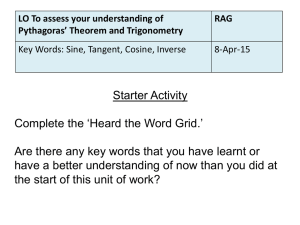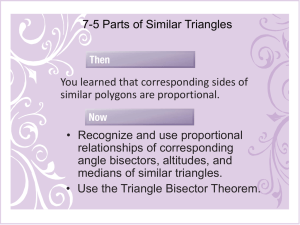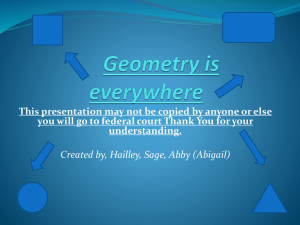Open - Inverness Royal Academy
advertisement
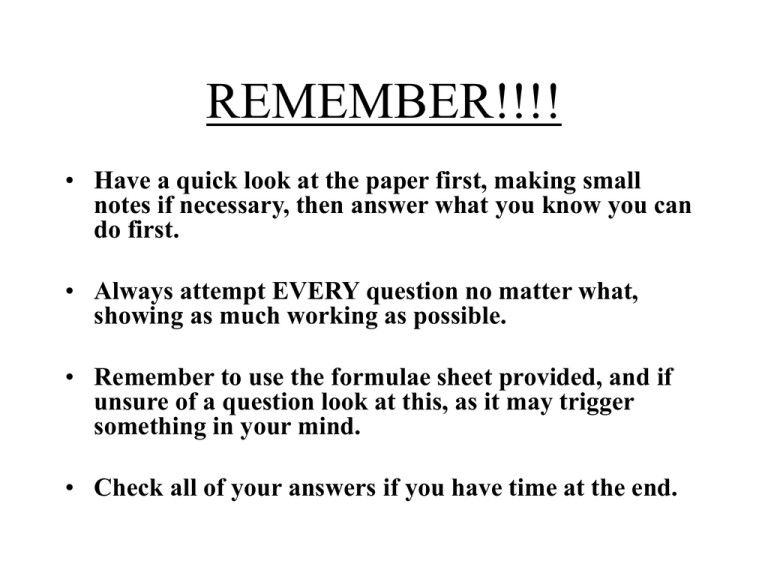
REMEMBER!!!!
• Have a quick look at the paper first, making small
notes if necessary, then answer what you know you can
do first.
• Always attempt EVERY question no matter what,
showing as much working as possible.
• Remember to use the formulae sheet provided, and if
unsure of a question look at this, as it may trigger
something in your mind.
• Check all of your answers if you have time at the end.
Formulae to Remember:The Formulae NOT given in exam which you must
know include:
To calculate the Area of a Sector
Area of a circle: A = r2
To find Arc Length
Circumference: C = D = 2r
Inter Quartile Range (measure main 50% spread in
Boxplots):
IQR = Q3 – Q1
Semi-Inter Quartile Range
SIQR = 1/2(Q3 - Q1)
Standard Form/Scientific Notation
(a x 10n)
The final value must be between 1 and 10
[i.e. 99 x 104 must be written as 9.9 x 105]
4230000 = 4.23 x 106
13280000 = 1.328 x 107
0.000975 = 9.75 x 10-4 2 million million = 2 x 1012
1.2 x 103 = 1200
2.91 x 10-2 = 0.0291
7.425 x 106 = 7425000
5.23 x 10-5= 0.0000523
More complex calculations
• A massive container holds 4.23 x 106 litres
• A spoon holds 1.52 x 10-2 litres
Question:-
How many spoonfuls fill the container?
give your answer to 3 sf & in standard form
Answer:-
(use EXP button on calculator for ease)
4.23 x 106 = (4.23 EXP6) = 278289473.684 =2.78 x 108
1.52 x 10-2 (1.52 EXP-2)
spoonfuls
Significant Figures
Round the figure to a certain number of important or significant digits.
It is NOT rounding to a certain amount of decimal places.
E.g. If you have to represent
2323 to 1sf you would write 2000 (NOT 2).
As the original number is in thousands, your rounded figure should still be
in thousands.
14243 to 1sf is 10000
16.932 to 1 sf is 20
14243 to 2sf is 14000
16.932 to 2 sf is 17
14243 to 3sf is 14200
16.932 to 3 sf is 16.9
1.2374 to 1 sf is 1
1.2374 to 2 sf is 1.2
1.2374 to 3 sf is 1.24
0.00237 to 1 sf is 0.002
0.00237 to 2 sf is 0.0024
0.00237 to 3 sf is 0.00237
• NB In the last example zeros are not significant at the front of a
number, the first significant digit must be one or more.
Conversion:
• Remember to pay attention to the units
required and to how many dec plcs/sig figs!
• 60mins 1 hr
• to convert into hours we must therefore 60
(secs to mins 60) (SDT!!!)
• 1cm3 = 1ml & 1000cm3 = 1000ml = 1litre
• 1m3 = 1m x 1m x 1m = 100cm x 100cm x 100cm
= 1,000,000cm3
Fractions
ADDING/SUBTRACTING:- the denominator must be the same
e.g. 2 + 5 = 2(y-1) + 5y = 2y-2 + 5y – 5 = 7y – 2
y (y-1)
y(y-1)
y(y-1)
y(y-1)
MULTIPLICATION:- Multiply straight over and then simplify
e.g. a x 2b = 2ab = b
4c a
4ac 2c
DIVISION:- Change to multiply turn fraction upside down
e.g. ab a = ab x 3c = 3abc = b
9c 3c 9c
a
9ac
3
•
•
Substitution **Remember (-3)2= 9 NOT –9 and follow rules of BODMAS!
BODMAS Brackets Order Divide Multiply Add then Subtract
Algebraic Fractions
• Remember to follow through from previous part of
factorising question if given an algebraic fraction, then
simplify wherever possible:
x2 – 8x + 7 = (x – 7) (x – 1) = (x – 1)
x 2 - 49
(x – 7) (x + 7) (x + 7)
Profit/Loss
(Appreciation/Depreciation) can be calculated as a
percentage by:-
Difference in Value x 100% = % Profit or Loss
Original Value
To make into a percentage.
Given 12 out of 30 pupils are girls, what is this as a percentage of all pupils?
12 out of 30 can be written as 12 = 4 = 40
30 10 100
{NB easier to make into a percent if over 10 or 100}
Compound Interest
Shortcut Method [£ x (1.00 + %)y]
Appreciation:- The value increases by itself (100%) + the %
increase
e.g 5% increase in value is (100% + 5%) = 105%
so multiplying factor 1.05
Depreciation:- The entire value decreases (100%) - % decrease
e.g 5% decrease in value is (100% - 5%) = 95%
so multiplying factor 0.95
Example of Compound Interest
Ex: Calculate compound interest when investing £720 at a
rate of 5.7% over 3 years?
An increase in 5.7% over 3 years can be written as
(1.00 + 0.057)3 (1.057) 3
£720 x (1.057) 3 = £850.27 (to the nearest penny)
[Only use this method if same percent change each year.]
Reversing Values
(i.e. Going Backwards to find original value** DIFFICULT)
After a 10% increase a house is worth £88 000. Find its
original value?
Original value = 100%
House is now valued at (100% + 10%) = 110%
= 1.10
House Value
110% £88 000
1.10 £88 000
1 £88 000 = £80 000
1.10
A car depreciates in value by 12% over the year
and is now £9680.
What was its value at the start of the year?
Original value = 100%
Car is now valued at (100% - 12%) = 88%
= 0.88
Original Car Value
88% £9 680
0.88 £9 680
1 £9 680 = £11 000
0.88
Circles
1 Arc Length is part of the circumference, so use
A x D
360
2 Area of a Sector is related to ‘Area’, so use
A x r2
360
3 In the circle a line, or tangent, to the circle creates an angle of 90o
4 Any triangle in a semi-circle with an angle touching the circle has an angle of 90o
5 Use radii, right angled triangles and Pythagoras theorem when given ‘Chords’
in a circle.
1&2
3
4
5
r
A
Chords
• Always use the radius in this question to create a
right angled triangle.
• Using Pythagoras or basic trig you may then find
the unknown side
• If finding the height of a tunnel take
unknown + radius
• If finding depth below take radius - unknown
Make into a right angled triangle
• Bottom depth will be H = (radius – x)
• Height will be
H = (radius + x)
• If to find radius need to use pythagoras &
solve algebraically as a Quadratic problem
x
r
x
r
r
r
(r-x)
x
r
Make into a right angled triangle
A
x
x
A
r
B
5cm
4cm
8cm
B
• Given AB = 8cm and r = 5cm find
the depth of water below chord AB?
• x2 = r2 – (OB)2
x2 = 52 – 42
= 25 – 16
=9
x = √9 = 3cm
Depth below AB:
D = (radius – x)
= 5cm - 3cm
= 2cm depth
Make into a right angled triangle
C
x
D
r
r
• x2 = r2 – (OD)2
x2 = 102 – 62
6cm
= 100 – 36
D
10cm
= 64
x = √64 = 8cm
r
12cm
C
x
10
• Given CD = 12cm and r = 10cm
• Find the water level Height at CD?
Water level at CD :
H = (radius + x)
= 10cm + 8cm
= 18cm high
Make into a right angled triangle
E
x
F
r
r
12cm
3 6cm
E (r - 3)
r cm
F
• Given EF = 12cm and x = 3cm
• Find the radius, r?
• r2 = (r - 3)2 + 62
r2 = r2 – 6r + 9 + 36
6r = 45
r = 45 = 7.5cm
6
Linear Relationships : y
= mx + c
Line cuts Y-axis at (0,c) thus can find value of ‘c’ by looking
at graph
Gradient is ‘m’ which can be found by
Gradient
m = Vertical = Rise = Difference in y’s = y2 - y1
Horizontal Run
Difference in x’s
x2 – x1
If asked to draw a line given an
equation:
• Make a small grid with x values 0, 1, 2 and plot line
i.e. if y = 3x - 4
Y = 3x – 4
• x 0 1 2
y -4 -1 2
thus can plot 3 coords (0, -4); (1, -1) & (2, 2)
and extend to draw a line
• Special Cases:Gradient = 0
Gradient Undefined
Remember Positive Gradients Uphill (Positive)
Negative Gradients Downhill (Negative)
& Parallel lines have the same gradient
Algebra: Opening Brackets
•
Always use a FOIL to help multiply two brackets
(x + 2)(x + 6)
= x2 + 2x + 6x + 12
= x2 + 8x + 12
(x - 4) 2= (x -4)(x - 4)
= x2 - 4x - 4x + 16
= x2 - 8x + 16
If a larger bracket is to be opened then it may be easier to use a grid:(x + 5)( x2 + 8x + 12)
= x3 + 8x2 + 5x2 + 12x + 40x + 60
= x3 +13x2 + 52x + 60
x2 + 8x + 12
x x3 + 8x2 + 12x
+5 5x2 + 40x + 60
x3 + 13x2 + 52x + 60
Understanding the signs
x2 + 5x + 4
= (x + ?)(x + ? )
= (x + 1)(x + 4)
All signs positive so either
1 x 4 or 2 x 2 to get 4 at end.
As 5 in middle => must use 1 and 4
x2 – 14x + 13
= (x - 1)(x - 13)
13 is positive, BUT -14x in middle
=> 2 negatives multiplied together to get +13
Prime number so can only be -1 x -13 which gives -14 in middle
x2 + 2x – 3
= (x + 3)(x - 1)
-3 implies must be 2 different signs + / - to give -3
-3 x 1 or 3 x 1. As +2x in middle must be 3 and -1
x2 – 6x – 7
= (x - 7)(x + 1)
-7 implies 2 different signs to make -7 => Either -7 x 1 or +7 x -1
As -6x in middle the larger number is influencing a negative result
Thus -7 and 1 shall give -6x in middle
Summary
x2 + ?x + ?
=> Both + & sum gives positive middle value
x2 – ?x + ?
=> Both – & sum gives negative middle value
x2 + ?x – ?
=> 2 different signs & difference gives
positive middle value (Large part is
Positive)
=> 2 different signs & difference gives
negative middle value (Largest part is
Negative)
x2 – ?x – ?
ALWAYS FOLLOW THE SAME PROCEDURE EACH
TIME WHEN FACTORISING:Is there a COMMON FACTOR?
i.e. 2x - 12x = 2x(x – 6)
Is there a DIFFERENCE OF TWO SQUARES?
4a – 25b2 = (2a) – (5b) = (2a + 5b)(2a – 5b)
Can it FACTORISE (Is it a trinomial in 3 parts?)
x – 8x + 7 = (x – 7)(x – 1)
ELSE if to solve to A SPECIFIC NUMBER OF DECIMAL PLACES
OR SIGNIFICANT FIGURES use the QUADRATIC FORMULA
Solving a Quadratic Problem
Example: Solve the following x2 – 8x + 7
for x
x2 – 8x + 7 = 0
(Set = 0 if not given)
(x – 7)(x – 1) = 0
(Factorise quadratic)
(x – 7) = 0 & (x – 1) = 0
x=7
&
x=1
Quadratic Formulae
Use when factorisation is not possible and asked
to a specific number of decimal places/significant figures
ax2 + bx + c = 0 and a 0
where a, b and c are constants from the quadratic
x = -b +/- (b2 - 4ac)
2a
(******* formula given on worksheet ********)
Sketch the graph of f(x) = (x - 4) 2 - 1
1.
2.
3.
4.
5.
Positive 'a' Happy U Minimum Tpt
Vertex (b,c) Minimum Tpt at (4, -1)
Symmetry at x = 4
Cuts y-axis at x=0,
y = (0 - 4)2 - 1 = (16) - 1= 15
So cuts at (0,15)
Cuts x-axis at y=0,
(x - 4) 2 - 1 = 0
x2 – 8x + 16 – 1 = 0
x2 – 8x + 15 = 0
(x – 3)(x – 5) = 0
x–3=0&x–5=0
x=3
& x=5
So cuts at (3, 0) & (5, 0)
Having obtained all information it is then possible to sketch the quadratic graph.
Volume of Solids
Volume of a Cone : V = 1r2h
3
[Easier to multiply values
Volume of a Sphere: V = 4r3
3
together and by 3 at the end]
*** 2 Formulae NOT Given to you
Vol of a Cylinder: V = r2h
& Vol of ANY Prism : V = Ah
(Main shape x height)
**** Make sure answer to the correct number of decimal ****
places OR significant figures, else marks will be lost!
Simultaneous Linear Equations :
3 Methods
•
1. Graphical:
This solves for the values of x and y where both lines have same value
(i.e. they cross/intersect). It is necessary to sketch two lines for this and the point of
intersection is the where the solution can be found.
•
2. Substitution:
Place one equation into the other and solve using substitution.
e.g y = 2x and y = -x + 12
y =3x and 7x + 2y = 39
If y = y using the method of substitution
2x = -x + 12
2x + x = 12
3x = 12
x=4
This time subst y = 3x into other equation
7x + 2y = 39
7x + 2(3x) = 39
7x + 6x = 3
13x = 39
x=3
Then find y using either equation given at start.
Simultaneous Linear Equations
3. Elimination:
Whenever presented with TWO EQUATIONS and you need
to find the values of x and y, p and q etc
Use the system of SIMULTANEOUS EQUATIONS
•
ALWAYS eliminating one variable to solve for one, then substitute this into
the equation to find the other.
•
SAME SIGNS => SUBTRACT EQUATIONS
•
DIFFERENT SIGNS => ADD EQUATIONS TOGETHER
•
Then use this value to find the other unknown choosing ANY equation.
Statistics
• You must know how to interpret, construct and present
the following:• Bar and Line graphs
• Stem and Leaf Plot and Pie charts
• Frequency tables, diagrams and polygons
• Cumulative Frequency diagrams
• Box Plots; Dot Plots and 5-Figure Summary
• Probability and Relative Frequency (same idea as
probability)
• Scatter Diagram
• Standard Deviation
Boxplots
•
1.
2.
3.
4.
5.
You must ORDER DATA & find the 5-figure Summary:L or Min - minimum value
Q1 - 1st/lower quartile
Q2 - median (or middle value)
Q3 - upper/3rd quartile
H or Max - maximum value
NOT given in the exam so MUST be remembered!
To find the spread of the main 50% of your information use:• The IQR (Inter Quartile Range) = (Q3 - Q1)
• SIR (semi-inter quartile range) is SIQR =1/2(Q3 - Q1)
Stem and Leaf Plots
Remember to put a key for the data
• Draw a vertical line with the main number group
being the ‘stem’, and the remaining smaller units
of the number being the ‘leaves’.
• Place in numerical order from the lowest to
highest value and represent every piece of data,
even if a number is repeated more than once.
Dot Plots
• Draw a horizontal scale from the lowest to
highest value
• Horizontal scale must be in numerical order.
• Represent each piece of data above the scale
with a dot
• If repeated values place a dot above the
previous data value entered.
Scatter Diagrams
Refer to “GCSE Maths Revision book” this is a
good example to follow.
Ensure line going through data cuts y-axis to find y
intercept, c.
Try to have same amount of data above & below
line, and about same distance from line.
Standard Deviation:
Method 1
• Create a table with 3 columns with the
following headings:
_
_
x (x – x) (x – x)2
x
• & mean of x being
_
(x - x)
_
(x - x)2
_
x bar, x = x n
Standard Deviation:
Method 2
• Create a table with 2 columns with the following
headings:
x2
x
x
x2
• (∑ means the total sum of)
• NB:- If presented with Standard Deviation data in the
format
• x2 = 12345 and x = 123 use the 2nd formula
given on the front sheet without creating a table.
Similar Shapes
• Similar triangles are Equiangular
have the same angles & sides are in proportion
Scale Factor (SF)
• Similar Areas.
Area units are cm2 (Scale Factor) 2
• Similar volumes have all dimensions in proportion i.e
Volume units are cm3 (Scale Factor) 3
Separate Similar Triangles
• When can’t see the problem clearly make a
new sketch by separating the triangles.
• This will make the problem far more clear.
Redraw complicated shapes
• Use z-shape angle rules & separate for simplicity
A
α
θ
*
C
*
B
C B θ
*
C
*
θ
D
α
θ
E D
α
α
E
A
Ratio and Proportion
Ratio
If Michael, Lisa and Stephanie share a bag of 81 sweets in the
ratio 2:3:4, how many sweets does each person get?
•
Add parts together to find total amount of shares
2+3+4=9
•
Take value and divide by total shares to find 1 share
81 9 = 9
•
When you have found 1 share 9 sweets here, you can then substitute
back into original ratio
2 : 3 : 4
2x9:3x9:4x9
18 : 27 : 36
•
Check by adding together 18 + 27 + 36 = 81 sweets
Problem Solving with Sequences
If given a sequence e.g. 3, 7, 11, 15,… find
the formula for the sequence:
E.g.
nth term 1 2 3 4 5 …. N
Sequence 3 7 11 15 19 … 4N – 1
+4 +4…. +4
(4*N ; As increases by 4 each time)
Variation
Direct Variation When both increase/decrease at
same rate i.e. as one halves the other halves
y = kx or y x
Inverse As x increases y decreases i.e.Time for
job to be completed reduces as manpower increases.
y = k or y 1
x
x
Surds
3 x 3
= 9
=3
2 x 50
= 100
= 10
12 3
= 4
=2
72
= 36 x 2
= 62
72 + 50 - 98
= (36 x 2) + (25 x 2) – (49 x 2)
= 62 + 52 – 72
= 42
• Can multiply/divide straight away
• You can only add/subtract if a ‘common surd’ exists .
• Remember Rationalise Do not leave as surd on denominator
Surds
Simplify and RATIONALISE:
5 3 + 1 = (5 3 + 1) x (4 3 – 7)
(43 + 7) (43 + 7)
(43 - 7)
= 2033 -35 3 + 43 – 7
1633 -283 + 283 – 49
Find the area of the rectangle:
(3 + 1) (23 – 5)
= (3 x 2 3) - 53 + 2 3 - 5
= 2 x 3 – 5 - 3 3
= 1- 3 3
(23 – 5)
= 20x3 - 313 - 7
16x3 – 49
= 60 – 7 - 313
48 – 49
= 313 – 53
-1
= 53 - 313
(3 + 1)
Indices
ax ay = ax-y
a7 a4 = a3
a5/2 a1/2 = a4/2 = a2
ax x ay = a x+y
a 2 x a3 = a 5
a3/2 x a5/2 = a8/2 = a4
a x/y = yax
82/3 = 3 (82)= 364 = 4
or
82/3 = (38)2 = 22 = 4
a0 = 1 and a-1 = 1
a
• Easy to remember that a ‘x’ sign is a slanted ‘+’ sign so if
multiplying weADD the powers
• If ‘’ or ‘/’ think of ‘-‘ within symbol i.e. when dividing indices we
SUBTRACT the powers
Indices
b1/2( b1/2 + b-3/2)
= (b1/2 x b1/2) + (b1/2 x b-3/2)
= b1/2+1/2 + b1/2 - 3/2
= b2/2 + b-2/2
= b + b-1
or b + 1
b
y7 x y-4
y3
a-4/5 x a-3/5
a-2/5
= y3
y3
= a-7/5
a-2/5
= y3-3
= a-7/5 –(-2/5)
= y0
= a-7/5+2/5
=1
= a-5/5
= a-1 or 1
a
Right Angled Triangles
• SOH CAH TOA and Pythagoras only in Right
Angled Triangles.
• Pythagoras if sides only c2 = a2 + b2
• If angles and sides use SOH CAH TOA
Sin x = O; Cos x = A; Tan x = O
H
H
A
Sine Rule
If NOT RIGHT ANGLED must consider other trig rules
When related angle and side present
(i.e. you can draw a diagonal between side and angle)
Use the Sine Rule
To find a side:
Reverse Sine Rule
To find an angle:
a = b = c
Sin A Sin B Sin C
Sin A = Sin B = Sin C
a
b
c
Cosine Rule
When two sides and unrelated angle use Cosine
Rule
a2 = b2 + c2 –2bc CosA
Or when 3 sides and no angle use Cosine Rule
CosA = b2 + c2 – a2
2bc
Area of Triangle
A = 1abSinC
2
Bearing Questions
• Extend North lines to create Z-shapes to
find as many angles as possible:
If trig question asks to find HEIGHT and
you do not have enough info to do this
• Remember to firstly find the slope using
sine rule or cosine rule
• Then use basic SOH CAH TOA
B
B
a?
A
b
H
a
C
A
b
Sketch 2 separate triangles
• Remember to firstly find the slope using
sine rule or cosine rule
• Then use basic SOH CAH TOA
Z
Z
w
h?
Y
Z
h
x?
W
X
W
X
Y
x
Trigonometric Graphs
Y = aSin(bx) + c & Y = aCos(bx) + c
a AMPLITUDE in front of function gives the height of the graph.
If unsure take the lowest to highest values and half to get height
b REPETITIONS is found within the function beside x.
[i.e. how many times it is repeated in 360o]
c moves the graph up/down the y-axis
Max = (c + a ) & Min = (c – a)
which tell us the Max/Min heights
The value of b also changes the PERIOD of the curve (360/b)
Period = 360/b
[The number of degrees for a complete wave]
Trigonometric Equations
1.
2.
3.
4.
Re-arrange equation to get trig function by itself
Use inverse function to find the 1st Quadrant angle
Select the appropriate Quadrants from the grid
below
Apply the appropriate rule to find the angles
(180 – x) SIN
(180 + x) TAN
ALL x
COS (360 – x)
Maximum Difference
• If the depth in metres, D, of water in the harbour at time t
is represented by the equation:
D = 11.3 + 5.7cos (50t)
• Find the MAXIMUM DIFFERENCE????????
• MAX D = 11.3 + 5.7 =17.0
• MIN D = 11.3 – 5.7 = 5.6
• THE MAX DIFFERENCE :- 17.0 – 5.6 = 11.4 metres
Things to remember
1. You can write with a pencil BUT you are
asked to write in pen
2. Make sure you bring your calculator and a
ruler
3. Calculator cases must be left outside exam
4. Get me to check your calculator screen in
the morning in case it is in the wrong
mode
Things to remember
5. BRING IN YOUR TEXT BOOKS, PAST
PAPERS, AND ALL SCHOOL BOOKS
ON DAY OF EXAM OR AS SOON AS
POSSIBLE AFTER THE EXAM!!!
6. THE NEW 4TH YEAR NEED THEM TO
START THEIR COURSE EVEN IF YOU
AREN’T STARTING 5TH YEAR YET!!
AND MOST OF ALL..
• ENJOY YOUR EXAM AND TRY YOUR
HARDEST….
• You have all the keys and skills to do well,
so go for it and enjoy yourself
REMEMBER!!!!
• Have a quick look at the paper first, making small
notes if necessary, then answer what you know you can
do first.
• Always attempt EVERY question no matter what,
showing as much working as possible.
• Remember to use the formulae sheet provided, and if
unsure of a question look at this, as it may trigger
something in your mind.
• Check all of your answers if you have time at the end.


